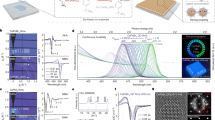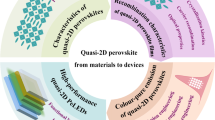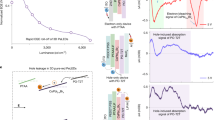Abstract
Ultrasmall CsPbI3 perovskite quantum dots (QDs) are the most promising candidates for realizing efficient and stable pure-red perovskite light-emitting diodes (PeLEDs)1,2,3,4,5. However, it is challenging for ultrasmall CsPbI3 QDs to retain their solution-phase properties when they assemble into conductive films, greatly hindering their device application3,6. Here we report an approach for in situ deposit stabilized ultrasmall CsPbI3 QD conductive solids, by constructing CsPbI3 QD/quasi-two-dimensional (quasi-2D) perovskite heteroepitaxy. The well-aligned periodic array of edge-oriented ligands at heterointerface triggers a substantial octahedral tilting in a critical layer thickness of CsPbI3 QDs, which heightens the Gibbs free energy difference between the tilted-CsPbI3 and δ-CsPbI3 leading to thermodynamic stabilization of CsPbI3 QDs. The approach allows us to fabricate stabilized CsPbI3 QD conductive films with tunable emission covering the entire red spectral region from 600 nm to 710 nm. Here we report the pure-red PeLEDs with narrow electroluminescence peak centred at 630 nm, matching the Rec. 2100 standard for ultrahigh-definition display. The champion device exhibits a certified external quantum efficiency of 24.6% and a half-lifetime of 6,330 min, ranking as one of the most efficient and stable pure-red PeLED reported to date. The approach is also compatible with large-area manufacturing, enabling 1 cm2 PeLED to exhibit the best external quantum efficiency of 20.5% at 630 nm.
This is a preview of subscription content, access via your institution
Access options
Access Nature and 54 other Nature Portfolio journals
Get Nature+, our best-value online-access subscription
$32.99 / 30 days
cancel any time
Subscribe to this journal
Receive 51 print issues and online access
$199.00 per year
only $3.90 per issue
Buy this article
- Purchase on SpringerLink
- Instant access to full article PDF
Prices may be subject to local taxes which are calculated during checkout




Similar content being viewed by others
Data availability
All data generated or analysed during this study are included in this paper and the Supplementary Information. Other data that support the findings of this study are available from the corresponding author upon reasonable request. The open-source StatSTEM software is available on GitHub (https://github.com/quantitativeTEM/StatSTEM).
References
Swarnkar, A. et al. Quantum dot–induced phase stabilization of α-CsPbI3 perovskite for high-efficiency photovoltaics. Science 354, 92–95 (2016).
Chiba, T. et al. Anion-exchange red perovskite quantum dots with ammonium iodine salts for highly efficient light-emitting devices. Nat. Photon. 12, 681–687 (2018).
Jiang, Y. et al. Synthesis-on-substrate of quantum dot solids. Nature 612, 679–684 (2022).
Li, H. et al. Nanosurface-reconstructed perovskite for highly efficient and stable active-matrix light-emitting diode display. Nat. Nanotechnol. 19, 638–645 (2024).
Li, Y. et al. Stable and efficient CsPbI3 quantum-dot light-emitting diodes with strong quantum confinement. Nat. Commun. 15, 5696 (2024).
Shamsi, J. et al. To nano or not to nano for bright halide perovskite emitters. Nat. Nanotechnol. 16, 1164–1168 (2021).
Li, M. et al. Acceleration of radiative recombination for efficient perovskite LEDs. Nature 630, 631–635 (2024).
Liu, Y. et al. Synergistic passivation and stepped-dimensional perovskite analogs enable high-efficiency near-infrared light-emitting diodes. Nat. Commun. 13, 7425 (2022).
Cao, Y. et al. Perovskite light-emitting diodes based on spontaneously formed submicrometre-scale structures. Nature 562, 249–253 (2018).
Guo, B. et al. Ultrastable near-infrared perovskite light-emitting diodes. Nat. Photon. 16, 637–643 (2022).
Zhao, B. et al. High-efficiency perovskite–polymer bulk heterostructure light-emitting diodes. Nat. Photon. 12, 783–789 (2018).
Xu, W. et al. Rational molecular passivation for high-performance perovskite light-emitting diodes. Nat. Photon. 13, 418–424 (2019).
Zhao, X. & Tan, Z.-K. Large-area near-infrared perovskite light-emitting diodes. Nat. Photon. 14, 215–218 (2020).
Xiong, W. et al. Controllable p- and n-type behaviours in emissive perovskite semiconductors. Nature 633, 344–350 (2024).
Kim, J. S. et al. Ultra-bright, efficient and stable perovskite light-emitting diodes. Nature 611, 688–694 (2022).
Ma, D. et al. Distribution control enables efficient reduced-dimensional perovskite LEDs. Nature 599, 594–598 (2021).
Lin, K. et al. Perovskite light-emitting diodes with external quantum efficiency exceeding 20 per cent. Nature 562, 245–248 (2018).
Hassan, Y. et al. Ligand-engineered bandgap stability in mixed-halide perovskite LEDs. Nature 591, 72–77 (2021).
Han, D. et al. Tautomeric mixture coordination enables efficient lead-free perovskite LEDs. Nature 622, 493–498 (2023).
Wang, Y. et al. Long-range order enabled stability in quantum dot light-emitting diodes. Nature 629, 586–591 (2024).
Kong, L. et al. Fabrication of red-emitting perovskite LEDs by stabilizing their octahedral structure. Nature 631, 73–79 (2024).
Jiang, J. et al. Efficient pure-red perovskite light-emitting diodes with strong passivation via ultrasmall-sized molecules. Sci. Adv. 10, eadn5683 (2024).
Song, Y. et al. Planar defect–free pure red perovskite light-emitting diodes via metastable phase crystallization. Sci. Adv. 8, eabq2321 (2022).
Protesescu, L. et al. Nanocrystals of cesium lead halide perovskites (CsPbX3, X = Cl, Br, and I): novel optoelectronic materials showing bright emission with wide color gamut. Nano Lett. 15, 3692–3696 (2015).
Steele, J. A. et al. Thermal unequilibrium of strained black CsPbI3 thin films. Science 365, 679–684 (2019).
Zhang, H. & Park, N.-G. Towards sustainability with self-healing and recyclable perovskite solar cells. eScience 2, 567–572 (2022).
Zeng, J. et al. Switchable interfacial reaction enables bright and stable deep-red perovskite light-emitting diodes. Nat. Photon. 18, 325–333 (2024).
Woodward, P. M. Octahedral tilting in perovskites. II. structure stabilizing forces. Acta Cryst. B53, 44–66 (1997).
Doherty, T. A. S. et al. Stabilized tilted-octahedra halide perovskites inhibit local formation of performance-limiting phases. Science 374, 1598–1605 (2021).
Chen, Y. et al. Strain engineering and epitaxial stabilization of halide perovskites. Nature 577, 209–215 (2020).
Voznyy, O. et al. Engineering charge transport by heterostructuring solution-processed semiconductors. Nat. Rev. Mater. 2, 17026 (2017).
Miao, Y. et al. In situ growth of ultra-thin perovskitoid layer to stabilize and passivate MAPbI3 for efficient and stable photovoltaics. eScience 1, 91–97 (2021).
Kepenekian, M. et al. Concept of lattice mismatch and emergence of surface states in two-dimensional hybrid perovskite quantum wells. Nano Lett. 18, 5603–5609 (2018).
Zhu, Z. et al. Room-temperature epitaxial welding of 3D and 2D perovskites. Nat. Mater. 21, 1042–1049 (2022).
Min, H. et al. Spin coating epitaxial heterodimensional tin perovskites for light-emitting diodes. Nat. Nanotechnol. 19, 632–637 (2024).
Liu, Y. et al. Efficient blue light-emitting diodes based on quantum-confined bromide perovskite nanostructures. Nat. Photon. 13, 760–764 (2019).
Quan, L. N. et al. Edge stabilization in reduced-dimensional perovskites. Nat. Commun. 11, 170 (2020).
Yao, J.-S. et al. Few-nanometer-sized α-CsPbI3 quantum dots enabled by strontium substitution and iodide passivation for efficient red-light emitting diodes. J. Am. Chem. Soc. 141, 2069–2079 (2019).
Gao, L. et al. Efficient near-infrared light-emitting diodes based on quantum dots in layered perovskite. Nat. Photon. 14, 227–233 (2020).
Liu, M. et al. Lattice anchoring stabilizes solution-processed semiconductors. Nature 570, 96–101 (2019).
Zhu, Y. et al. Unravelling surface and interfacial structures of a metal–organic framework by transmission electron microscopy. Nat. Mater. 16, 532–536 (2017).
Li, C., Loh, K. P. & Leng, K. Organic-inorganic hybrid perovskites and their heterostructures. Matter 5, 4153–4169 (2022).
Cai, N. et al. Synergistical dipole–dipole interaction induced self-assembly of phenoxazine-based hole-transporting materials for efficient and stable inverted perovskite solar cells. Angew. Chem. Int. Ed. 60, 20437–20442 (2021).
Metrangolo, P. et al. Halogen bonding in perovskite solar cells: a new tool for improving solar energy conversion. Angew. Chem. Int. Ed. 61, e202114793 (2022).
Najarian, A. M. et al. Homomeric chains of intermolecular bonds scaffold octahedral germanium perovskites. Nature 620, 328–335 (2023).
Liu, D. et al. Strain analysis and engineering in halide perovskite photovoltaics. Nat. Mater. 20, 1337–1349 (2021).
Jia, D. et al. Inhibiting lattice distortion of CsPbI3 perovskite quantum dots for solar cells with efficiency over 16.6%. Energy Environ. Sci. 15, 4201–4212 (2022).
Li, Z. et al. Charge injection engineering at organic/inorganic heterointerfaces for high-efficiency and fast-response perovskite light-emitting diodes. Nat. Commun. 14, 6441 (2023).
Shi, E. et al. Two-dimensional halide perovskite lateral epitaxial heterostructures. Nature 580, 614–620 (2020).
Yu, Y. et al. Atomic resolution imaging of halide perovskites. Nano Lett. 16, 7530–7535 (2016).
Backer, A. D., Bos, K. H. W. van den, Broek, W. V. Van den, Sijbers, J. & Aert, S. V. Van StatSTEM: an efficient approach for accurate and precise model-based quantification of atomic resolution electron microscopy images. Ultramicroscopy 171, 104–116 (2016).
Zhu, Y., Withers, R. L., Bourgeois, L., Dwyer, C. & Etheridge, J. Direct mapping of Li-enabled octahedral tilt ordering and associated strain in nanostructured perovskites. Nat. Mater. 14, 1142–1149 (2015).
Galindo, P. L. et al. The peak pairs algorithm for strain mapping from HRTEM images. Ultramicroscopy 107, 1186–1193 (2007).
Shi, Z. et al. Strategy of solution-processed all-Inorganic heterostructure for humidity/temperature-stable perovskite quantum dot light-emitting diodes. ACS Nano 12, 1462–1472 (2018).
Kresse, G. & Furthmüller, J. Efficient iterative schemes for ab initio total-energy calculations using a plane-wave basis set. Phys. Rev. B 54, 11169–11186 (1996).
Perdew, J. P., Burke, K. & Ernzerhof, M. Generalized gradient approximation made simple. Phys. Rev. Lett. 77, 3865–3868 (1996).
Grimme, S., Ehrlich, S. & Goerigk, L. Effect of the damping function in dispersion corrected density functional theory. J. Comput. Chem. 32, 1456–1465 (2011).
Stoumpos, C. C. et al. Ruddlesden−popper hybrid lead iodide perovskite 2D homologous semiconductors. Chem. Mater. 28, 2852–2867 (2016).
Wang, V. et al. VASPKIT: a user-friendly interface facilitating high-throughput computing and analysis using VASP code. Comput. Phys. Commun. 267, 108033 (2021).
Togo, A. & Tanaka, I. First principles phonon calculations in materials science. Scr. Mater. 108, 1–5 (2015).
Blöchl, P. E. Projector augmented-wave method. Phys. Rev. B 50, 17953–17979 (1994).
Grimme, S., Antony, J., Ehrlich, S. & Krieg, H. A consistent and accurate ab initio parametrization of density functional dispersion correction (DFT-D) for the 94 elements H-Pu. J. Chem. Phys. 132, 154104 (2010).
Chadi, D. J. Special points for brillouin-zone integrations. Phys. Rev. B 16, 1746–1747 (1977).
Wang, K. et al. Suppressing phase disproportionation in quasi-2D perovskite light-emitting diodes. Nat. Commun. 14, 397 (2023).
Acknowledgements
This work is financially supported by the National Science Fund for Distinguished Young Scholars (grant no T2225024), Foundation for Innovative Research Groups of the National Natural Science Foundation of China (Grant No. 22121005), National Science Foundation (Grant No. 62261160389 and 52072185). The authors extend their appreciation to the Deputyship for Research and Innovation, Ministry of Education in Saudi Arabia for funding this research work through the project no. (IFKSU-DSR-NS2). We thank the staff of beamlines BL17B1, BL14B1, BL03HB and BL02U2 at SSRF for providing the beam time and User Experiment Assist System of SSRF for their help. We thank the staff at the State Key Laboratory of Medicinal Chemical Biology of Nankai University for their assistance with collecting cryo-EM data. This work was partly supported by Analysis Platform of New Matter Structure at Nankai University.
Author information
Authors and Affiliations
Contributions
M.Y. conceived the idea. M.Y., J.C. and W.Z. guided the project. K.W., Y.J. and M.Y. developed the approach for the fabrication of perovskite heteroepitaxy. K.W. synthesized the materials and perovskite films. K.W., S.Li, Xinliang Fu, C.H., Y.J., H.-Y.H., W.-D.L. and J.T.K. characterized the materials and perovskite films. Y.Y. carried out the GIWAXS measurements and provided the analyses. S. Liu, Xuewen Fu, N.A. and S.M.H.Q. performed the transient absorption and analysed the data. K.W. prepared the TEM samples. T.Z. and W.Z. carried out the TEM characterizations and analyses. K.W. and C.S. carried out the device fabrication and characterizations. S.T. and M.K.N. performed the optical simulations of PeLEDs. Y.L. and R.L. carried out theoretical calculations. K.W., T.Z., W.Z., J.C. and M.Y. co-wrote the paper. All authors discussed the results and commented on the paper.
Corresponding authors
Ethics declarations
Competing interests
The authors have filed a provisional patent for this work to the China National Intellectual Property Administration (CNIPA).
Peer review
Peer review information
Nature thanks the anonymous reviewers for their contribution to the peer review of this work.
Additional information
Publisher’s note Springer Nature remains neutral with regard to jurisdictional claims in published maps and institutional affiliations.
Extended data figures and tables
Extended Data Fig. 1 Photoluminescence spectra of se-epitaxy films.
a, The se-epitaxy films exhibited tunable photoluminescence wavelength by varying the Br-DMA+ ligand concentrations from 0.02 M to 0.28 M with incorporation of PEA+ co-ligands. b,c, Photoluminescence spectra of se-epitaxy films with photoluminescence peak at 631 nm (b) and 645 nm (c) plotting in linear scale (light dashed lines) and log scale (dark solid lines).
Extended Data Fig. 2 Ultrafast transient absorption (TA) spectra and corresponding photoluminescence spectra for se-epitaxy and de-epitaxy films with different bandgap.
a-c, Transient absorption spectra of se-epitaxy films with photoluminescence peak at 634 nm (a), 672 nm (b), and 700 nm (c). d-f, Corresponding absorption (grey solid lines) and photoluminescence spectra of se-epitaxy films, where the photoluminescence spectra were plotted in linear scale (green dashed lines) and log scale (green solid lines). g-i, Transient absorption spectra of de-epitaxy films with photoluminescence peak at 633 nm (g), 670 nm (h), and 700 nm (i). j-l, Corresponding absorption (grey solid lines) and photoluminescence spectra of de-epitaxy films, where the photoluminescence spectra were plotted in linear scale (blue dashed lines) and log scale (blue solid lines).
Extended Data Fig. 4 Electron tomography (ET) reconstruction of se-epitaxy composite.
a, Schematic of ET structure reconstruction. b, HRTEM image of a representative se-epitaxy composite. c-e, 3D reconstruction images for the representative se-epitaxy composite under various viewing angles. Inset: schematic illustrations of se-epitaxy composites. The reconstruction images reveal a complete nanoparticle in the blue region with size of 7.4 nm × 7.0 nm × 11.4 nm and a single-edge-attached nanoplate in red region, identifying as CsPbI3 QD/quasi-2D perovskite single-edge attached epitaxy (se-epitaxy).
Extended Data Fig. 5 Orientation instructions in se-epitaxy and de-epitaxy.
a, Unit cell model of γ-CsPbI3 viewed along the \([1\bar{1}0]\) zone axis. b, Unit cell model of α-CsPbI3 viewed along the [\(001\)] zone axis. c, Unit cell model of PEA+-based quasi-2D perovskites viewed along the [\(110\)] zone axis. d, Atomic-scale HAADF image of the Br-DMA+-based γ-CsPbI3 and PEA+-based quasi-2D perovskites obtained from Fig. 1j. The unit cell model is consistent with the microstructure, indicating that \([1\bar{1}0]\)γ-CsPbI3 is parallel to [\(110\)]PEA+ based quasi-2D perovskites. This orientation relationship indicates that (110)γ-CsPbI3 is parallel to \((1\bar{1}0)\)PEA+ based quasi-2D perovskites. e, Unit cell model of Br-PEA+-based quasi-2D perovskites viewed along the [\(110\)] zone axis. f,g, Atomic-scale HAADF images of the Br-DMA+-based γ-CsPbI3 and Br-PEA+-based quasi-2D perovskites obtained from the bottom (f) and top (g) heterointerface area in Fig. 2g. The unit cell model is consistent with the microstructure, indicating that \([1\bar{1}0]\)γ-CsPbI3 is parallel to [\(110\)]Br-PEA+ based quasi-2D perovskites. This orientation relationship indicates that (110)γ-CsPbI3 is parallel to \((1\bar{1}0)\)Br-PEA+ based quasi-2D perovskites.
Extended Data Fig. 6 Heteroepitaxial interface structure and corresponding strain analysis in se-epitaxy and de-epitaxy composites.
a, Low-dose HRTEM image of representative se-epitaxy composite. b, Enlarged HRTEM image of the region marked by white solid box in (a). c, Simulation model of the heterointerface in se-epitaxy composite. d, The εxx strain mapping of CsPbI3 QD (marked by blue dashed boxes) in se-epitaxy (a) composite. e, The εxx strain mapping of CsPbI3 QD (marked by blue dashed boxes) in de-epitaxy composite (Fig. 2k).
Extended Data Fig. 7 Structural characterizations of the de-epitaxy composites.
a,b, Atomic-scale HAADF images of de-epitaxy composite with various particle sizes. c,d, Corresponding plots of octahedral tilting angle as a function of the [PbI6]4− unit cell across the CsPbI3 QDs (along the x-direction), with corresponding 95% confidence bands. The data presented as mean ± standard deviation of twelve [PbI6]4− unit cells in the y-direction.
Extended Data Fig. 9 The de-epitaxy PeLED with electroluminescence peak at 600 nm.
a,b, The current density-voltage-luminescence (J-V-L) curves (a), and EQE-J curve (b) of PeLED with active area of 8.6 mm2. Inset to (b): electroluminescence spectrum of PeLED. c, The photograph of large-area (4 cm2) PeLED with electroluminescence peak at 600 nm. d, The luminance mapping of large-area PeLED under operating voltage of 4.5 V (c).
Extended Data Fig. 10 Device performance of large-area (1 cm2) de-epitaxy PeLEDs.
a-f, Device performance of PeLED with electroluminescence peak centered at 630 nm. The corresponding J-V-L curves (a), EQE-J curve (b), electroluminescence spectra at different voltage bias (c), angle-dependent electroluminescence intensity (d), histogram of EQE (e) and luminance mapping under operating voltage of 5.0 V (f). g, Photograph of large-area (1 cm2) PeLEDs with electroluminescence peak ranging from 600 nm to 660 nm.
Supplementary information
Supplementary Information
Supplementary Notes 1–8, including Supplementary Figs. 1–22 and Supplementary Tables 1–3.
Rights and permissions
Springer Nature or its licensor (e.g. a society or other partner) holds exclusive rights to this article under a publishing agreement with the author(s) or other rightsholder(s); author self-archiving of the accepted manuscript version of this article is solely governed by the terms of such publishing agreement and applicable law.
About this article
Cite this article
Wei, K., Zhou, T., Jiang, Y. et al. Perovskite heteroepitaxy for high-efficiency and stable pure-red LEDs. Nature 638, 949–956 (2025). https://doi.org/10.1038/s41586-024-08503-9
Received:
Accepted:
Published:
Issue date:
DOI: https://doi.org/10.1038/s41586-024-08503-9
This article is cited by
-
All-site alloyed perovskite for efficient and bright blue light-emitting diodes
Nature Communications (2025)



